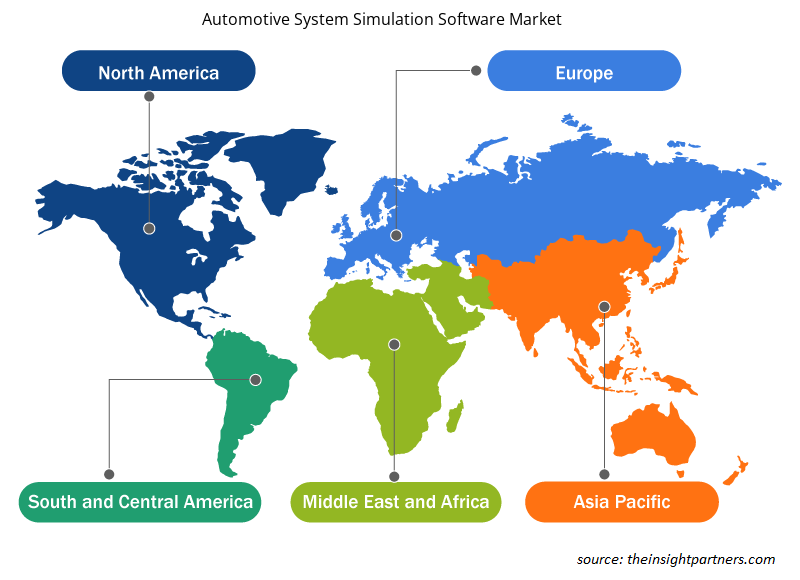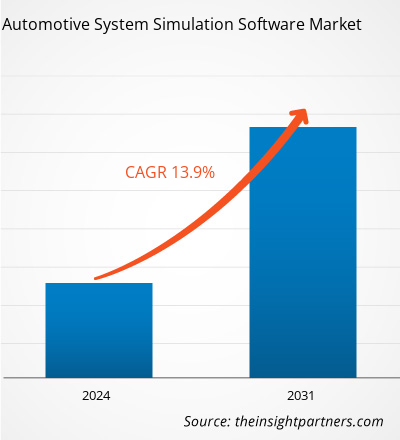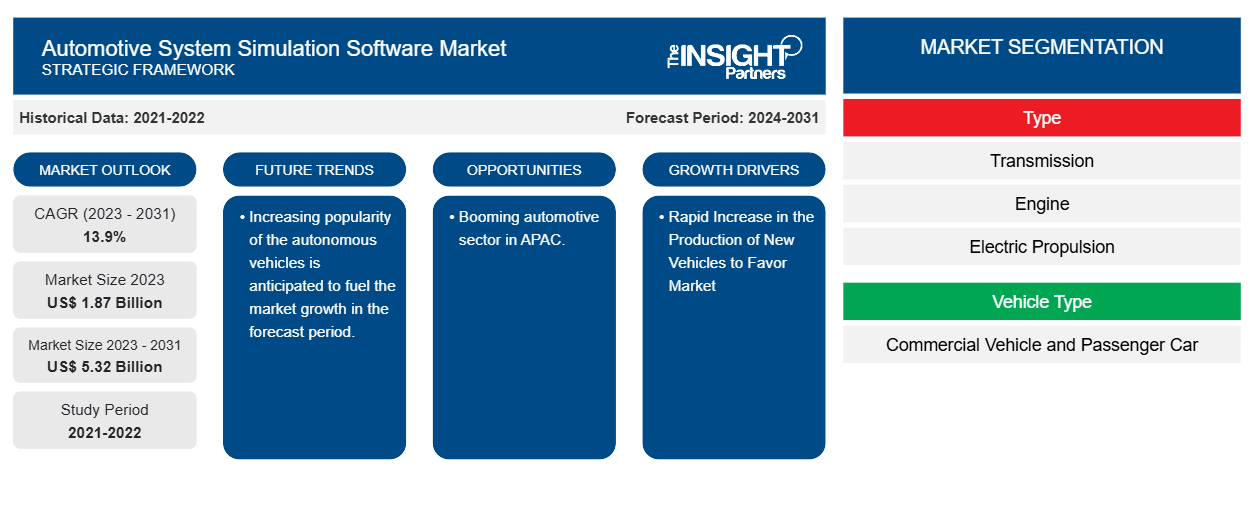Der Markt für Simulationssoftware für Automobilsysteme soll von 1,87 Milliarden US-Dollar im Jahr 2023 auf 5,32 Milliarden US-Dollar im Jahr 2031 anwachsen. Der Markt wird zwischen 2023 und 2031 voraussichtlich eine durchschnittliche jährliche Wachstumsrate von 13,9 % verzeichnen. Die Verbesserung der Fahrzeugfunktionen und die Zunahme der Anzahl von E/E-Komponenten sowie die wachsende Produktion und der Verkauf von Elektrofahrzeugen werden voraussichtlich weiterhin wichtige Trends und Treiber des Marktes bleiben.
Marktanalyse für Automotive Systemsimulationssoftware
Die Nachfrage nach Software zur Simulation von Automobilsystemen dürfte mit der rasanten Zunahme der Produktion neuer Fahrzeuge wachsen. OEMs verlagern ihre konventionellen Prototyping-Methoden auf die Simulation von Automobilsystemen, um neue Modelle zu entwickeln und bestehende zu verbessern, was den Markt für Software zur Simulation von Automobilsystemen beflügelt.
Marktübersicht für Automobilsystem-Simulationssoftware
Die Automotive Systems Simulation Software (ASM) ist eine Tool-Suite, die Simulationsmodelle für Automotive-Anwendungen umfasst, die nach Bedarf zusammengeführt werden können. Die Modelle unterstützen ein breites Spektrum an Simulationen, angefangen bei Einzelkomponenten wie Verbrennungsmotoren oder Elektromotoren über Fahrdynamiksysteme bis hin zu komplexen virtuellen Verkehrsszenarien. Die Modelle lassen sich mit ModelDesk, der grafischen Benutzeroberfläche, einfach und intuitiv handhaben.
Passen Sie diesen Bericht Ihren Anforderungen an
Sie erhalten kostenlose Anpassungen an jedem Bericht, einschließlich Teilen dieses Berichts oder einer Analyse auf Länderebene, eines Excel-Datenpakets sowie tolle Angebote und Rabatte für Start-ups und Universitäten.
-
Holen Sie sich die wichtigsten Markttrends aus diesem Bericht.Dieses KOSTENLOSE Beispiel umfasst eine Datenanalyse von Markttrends bis hin zu Schätzungen und Prognosen.
Markttreiber und Chancen für Software zur Automobilsystem-Simulation
Schneller Anstieg der Produktion neuer Fahrzeuge begünstigt den Markt
Der rasante Anstieg der Produktion neuer Fahrzeuge treibt das Wachstum des Marktes für Simulationssoftware für Automobilsysteme voran. Da die Produktion neuer Fahrzeuge zunimmt, steigt auch die Nachfrage nach Simulationssoftware für Automobilsysteme. Laut der Association des Constructeurs Européens d'Automobiles (ACEA) wurden im Jahr 2022 beispielsweise weltweit 85,4 Millionen Kraftfahrzeuge produziert, was einem Anstieg von 5,7 % gegenüber 2021 entspricht. Daher kann die Steigerung der Produktion neuer Kraftfahrzeuge das Wachstum des Marktes für Simulationssoftware für Automobilsysteme vorantreiben.
Boomender Automobilsektor im Asien-Pazifik-Raum.
Die Automobilindustrie in der Region Asien-Pazifik boomt seit einigen Jahren. Das Wachstum wird durch die rasche Urbanisierung, den wirtschaftlichen Wohlstand und die steigende Bevölkerung vorangetrieben. Der Mobilitätsbedarf in den asiatischen Ländern für Menschen und Güter ist gestiegen. Darüber hinaus werden Automobile im Laufe der Zeit modernisiert. Darüber hinaus konzentrieren sich Unternehmen wie KIA, Nio und viele andere in der Region auf die Produktentwicklung.
Marktbericht zur Simulation von Automobilsystemen – Segmentierungsanalyse
Wichtige Segmente, die zur Ableitung der Marktanalyse für Automobilsystemsimulationssoftware beigetragen haben, sind Typ, Fahrzeugtyp und Antriebsart.
- Basierend auf dem Typ ist der Markt für Automobil-Systemsimulationssoftware in Getriebe, Motor , Elektroantrieb, Brennstoffzelle, Antriebsstrang, Fahrwerk und andere unterteilt. Das Getriebesegment dürfte im Prognosezeitraum den größten Anteil haben.
- Basierend auf dem Fahrzeugtyp ist der Markt für Automobil-Systemsimulationssoftware in Nutzfahrzeuge und Personenkraftwagen unterteilt. Das Nutzfahrzeugsegment dürfte im Prognosezeitraum den größten Anteil haben.
- Basierend auf der Antriebsart ist der Markt für Automobil-Systemsimulationssoftware in Verbrennungsmotoren und Elektroantriebe unterteilt. Das Verbrennungsmotor-Segment dürfte im Prognosezeitraum den größten Anteil haben.
Marktanteilsanalyse für Automotive Systems Simulation Software nach geografischen Gesichtspunkten
Der geografische Umfang des Marktberichts zur Automobil-System-Simulationssoftware ist hauptsächlich in fünf Regionen unterteilt: Nordamerika, Asien-Pazifik, Europa, Naher Osten und Afrika sowie Süd- und Mittelamerika.
APAC dominiert den Markt. Die Region ist Heimat mehrerer Hersteller, die sich auf moderne technologische Fortschritte konzentrieren. Außerdem besteht die Region aus Schwellenländern, darunter China, Japan und Indien. Diese Länder verfügen über bedeutende Automobilindustrien. Darüber hinaus erhöhen Urbanisierung und Industrialisierung die Nachfrage nach einer großen Anzahl von Fahrzeugen, was den Markt für Automobil-Systemsimulationssoftware in der Region antreibt.
Regionale Einblicke in den Markt für Automobilsystem-Simulationssoftware
Die regionalen Trends und Faktoren, die den Markt für Automotive Systems Simulation Software im Prognosezeitraum beeinflussen, wurden von den Analysten von Insight Partners ausführlich erläutert. In diesem Abschnitt werden auch die Marktsegmente und die Geografie von Automotive Systems Simulation Software in Nordamerika, Europa, im asiatisch-pazifischen Raum, im Nahen Osten und Afrika sowie in Süd- und Mittelamerika erörtert.

- Erhalten Sie regionale Daten zum Markt für Automobil-Systemsimulationssoftware
Umfang des Marktberichts zur Simulationssoftware für Automobilsysteme
| Berichtsattribut | Details |
|---|---|
| Marktgröße im Jahr 2023 | 1,87 Milliarden US-Dollar |
| Marktgröße bis 2031 | 5,32 Milliarden US-Dollar |
| Globale CAGR (2023 - 2031) | 13,9 % |
| Historische Daten | 2021-2022 |
| Prognosezeitraum | 2024–2031 |
| Abgedeckte Segmente |
Nach Typ
|
| Abgedeckte Regionen und Länder |
Nordamerika
|
| Marktführer und wichtige Unternehmensprofile |
|
Dichte der Marktteilnehmer für Automotive Systems Simulation Software: Die Auswirkungen auf die Geschäftsdynamik verstehen
Der Markt für Automotive Systems Simulation Software wächst rasant, angetrieben durch die steigende Nachfrage der Endnutzer aufgrund von Faktoren wie sich entwickelnden Verbraucherpräferenzen, technologischen Fortschritten und einem größeren Bewusstsein für die Vorteile des Produkts. Mit steigender Nachfrage erweitern Unternehmen ihr Angebot, entwickeln Innovationen, um die Bedürfnisse der Verbraucher zu erfüllen, und nutzen neue Trends, was das Marktwachstum weiter ankurbelt.
Die Marktteilnehmerdichte bezieht sich auf die Verteilung der Firmen oder Unternehmen, die in einem bestimmten Markt oder einer bestimmten Branche tätig sind. Sie gibt an, wie viele Wettbewerber (Marktteilnehmer) in einem bestimmten Marktraum im Verhältnis zu seiner Größe oder seinem gesamten Marktwert präsent sind.
Die wichtigsten Unternehmen auf dem Markt für Automobilsystem-Simulationssoftware sind:
- ESI-Gruppe
- ANSYS, Inc
- Hexagon AB
- dSPACE GmbH
- Siemens
- Modellon
Haftungsausschluss : Die oben aufgeführten Unternehmen sind nicht in einer bestimmten Reihenfolge aufgeführt.

- Überblick über die wichtigsten Akteure auf dem Markt für Automobilsystem-Simulationssoftware
Marktnachrichten und aktuelle Entwicklungen zur Simulationssoftware für Automobilsysteme
Der Markt für Simulationssoftware für Automobilsysteme wird durch die Erfassung qualitativer und quantitativer Daten nach Primär- und Sekundärforschung bewertet, die wichtige Unternehmensveröffentlichungen, Verbandsdaten und Datenbanken umfasst. Nachfolgend sind einige der Entwicklungen auf dem Markt für Simulationssoftware für Automobilsysteme aufgeführt:
- Altair, einer der weltweit führenden Anbieter von Computational Intelligence, gab die Übernahme von Research in Flight bekannt, dem Hersteller von FlightStream, das Software für numerische Strömungsmechanik (CFD) anbietet, die in der Luft- und Raumfahrt sowie im Verteidigungssektor weit verbreitet ist und in den Bereichen Schifffahrt, Energie, Turbomaschinen und Automobile immer stärker vertreten ist. FlightStream ist ein benutzerfreundlicher und dennoch leistungsstarker Strömungslöser, der die Lücke zwischen hochpräzisen CFD-Simulationen und den Anforderungen von Ingenieuren und Designern schließt. (Quelle: Altair, Unternehmenswebsite, Mai 2024)
- Rohde & Schwarz hat sich mit IPG Automotive, einem Pionier im virtuellen Fahrversuch, zusammengetan, um Hardware-in-the-Loop (HIL)-Integrationstests für Automotive-Radar neu zu definieren und so die Kosten zu senken, indem Tests für autonomes Fahren (AD) vom Prüfgelände in das Entwicklungslabor gebracht werden. Durch die Kombination der CarMaker-Simulationssoftware von IPG Automotive mit dem Radarobjektsimulator R&S AREG800A und dem fortschrittlichen Antennenarray R&S QAT100 können Fahrzeughersteller ADAS/AD-Szenarien wie die im Euro NCAP definierten auf kontrollierte, sichere, zeiteffiziente und kostensenkende Weise simulieren. (Quelle: Rohde & Schwarz Unternehmenswebsite, April 2024)
Marktbericht zur Simulationssoftware für Automobilsysteme – Umfang und Ergebnisse
Der Bericht „Marktgröße und Prognose für Automobilsystem-Simulationssoftware (2021–2031)“ bietet eine detaillierte Analyse des Marktes, die die folgenden Bereiche abdeckt:
- Marktgröße und Prognose für Automotive-System-Simulationssoftware auf globaler, regionaler und Länderebene für alle abgedeckten wichtigen Marktsegmente.
- Markttrends und Marktdynamiken für Software zur Automobilsystem-Simulation sowie Treiber, Einschränkungen und wichtige Chancen.
- Detaillierte PEST/Porters Five Forces- und SWOT-Analyse
- Analyse des Marktes für Automotive-System-Simulationssoftware, die wichtige Markttrends, globale und regionale Rahmenbedingungen, wichtige Akteure, Vorschriften und aktuelle Marktentwicklungen umfasst.
- Branchenlandschaft und Wettbewerbsanalyse, einschließlich Marktkonzentration, Heatmap-Analyse, prominenten Akteuren und aktuellen Entwicklungen auf dem Markt für Automobil-System-Simulationssoftware.
- Detaillierte Firmenprofile.
- Historische Analyse (2 Jahre), Basisjahr, Prognose (7 Jahre) mit CAGR
- PEST- und SWOT-Analyse
- Marktgröße Wert/Volumen – Global, Regional, Land
- Branchen- und Wettbewerbslandschaft
- Excel-Datensatz
Aktuelle Berichte
Verwandte Berichte
Erfahrungsberichte
Grund zum Kauf
- Fundierte Entscheidungsfindung
- Marktdynamik verstehen
- Wettbewerbsanalyse
- Kundeneinblicke
- Marktprognosen
- Risikominimierung
- Strategische Planung
- Investitionsbegründung
- Identifizierung neuer Märkte
- Verbesserung von Marketingstrategien
- Steigerung der Betriebseffizienz
- Anpassung an regulatorische Trends























 Kostenlose Probe anfordern für - Markt für Simulationssoftware für Automobilsysteme
Kostenlose Probe anfordern für - Markt für Simulationssoftware für Automobilsysteme